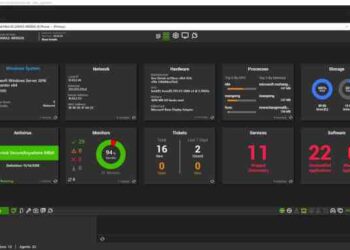Delving into the realm of Cloud-based RMM software providers opens up a world of possibilities and efficiencies for businesses seeking streamlined operations and enhanced performance. As technology continues to evolve, the adoption of cloud-based solutions has become increasingly crucial in optimizing IT management processes.
In this guide, we will navigate through the landscape of Cloud-based RMM software providers, uncovering key features, benefits, implementation processes, and security considerations that are essential for businesses striving for success in the digital age.
Overview of Cloud-based RMM Software Providers
Cloud-based Remote Monitoring and Management (RMM) software refers to a solution that enables IT service providers to remotely monitor and manage their clients' endpoints and networks through a cloud-based platform. This type of software allows for efficient monitoring, maintenance, and troubleshooting of IT systems without the need for physical presence at the client's location.
Key Features of Cloud-based RMM Software Providers
- Real-time Monitoring: Cloud-based RMM software providers offer real-time monitoring of endpoints, networks, and devices, allowing IT professionals to quickly identify and address issues as they arise.
- Automated Maintenance: These solutions automate routine maintenance tasks such as software updates, patch management, and security configurations, reducing manual intervention and improving efficiency.
- Remote Access and Control: Cloud-based RMM software provides IT teams with remote access to client systems, enabling them to troubleshoot problems, install software, and perform maintenance tasks without physical access to the devices.
- Alerts and Notifications: Providers offer customizable alerts and notifications for critical events, allowing IT professionals to proactively address issues and minimize downtime.
- Scalability: Cloud-based RMM software is scalable, allowing IT service providers to easily add or remove endpoints as needed without significant infrastructure changes.
Benefits of Cloud-based RMM Software over Traditional Solutions
- Cost-Efficiency: Cloud-based RMM software eliminates the need for expensive hardware infrastructure and maintenance, reducing costs for IT service providers.
- Accessibility: Cloud-based solutions offer remote access to monitoring and management tools from anywhere with an internet connection, providing flexibility and convenience for IT teams.
- Increased Efficiency: Automation features and real-time monitoring capabilities of cloud-based RMM software result in faster issue resolution and improved productivity for IT professionals.
- Enhanced Security: Cloud-based RMM software providers often implement robust security measures to protect client data and ensure compliance with industry regulations.
- Scalability: Cloud-based solutions can easily scale to accommodate the growth of IT service providers' client base without the need for additional hardware investments.
Leading Cloud-based RMM Software Providers
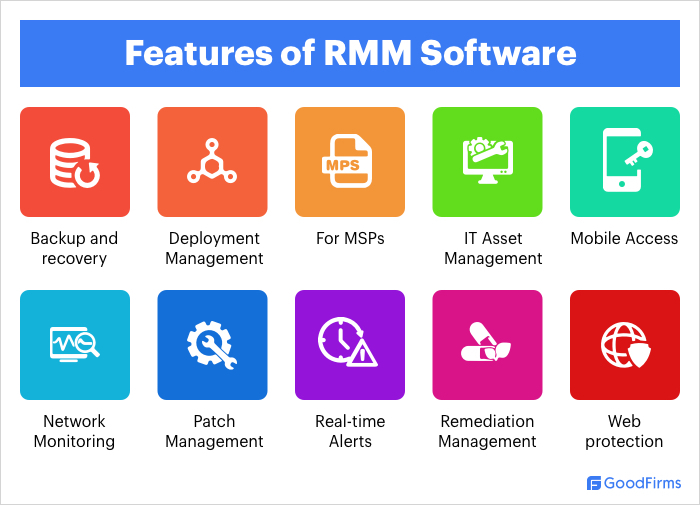
When it comes to Cloud-based RMM software providers, there are several prominent players in the market offering a range of services to businesses of all sizes. These providers stand out for their scalability, customization options, and pricing models tailored to meet varying business needs.
Prominent Cloud-based RMM Software Providers
Here are some of the leading Cloud-based RMM software providers:
- ConnectWise Automate
- SolarWinds N-central
- Kaseya VSA
- Datto RMM
- Atera
Scalability and Customization
Each of these providers offers scalable solutions that can be customized to fit the specific needs of businesses. They provide features such as remote monitoring, patch management, automation, and reporting tools that can be tailored to meet the requirements of different organizations.
Pricing Models
When it comes to pricing, Cloud-based RMM software providers typically offer subscription-based models that cater to varying business needs. Some providers offer tiered pricing based on the number of endpoints or devices being managed, while others may have flat-rate pricing options.
Additionally, providers may offer add-on services or modules for an extra cost, allowing businesses to choose the features that best suit their requirements and budget.
Implementation and Integration Processes
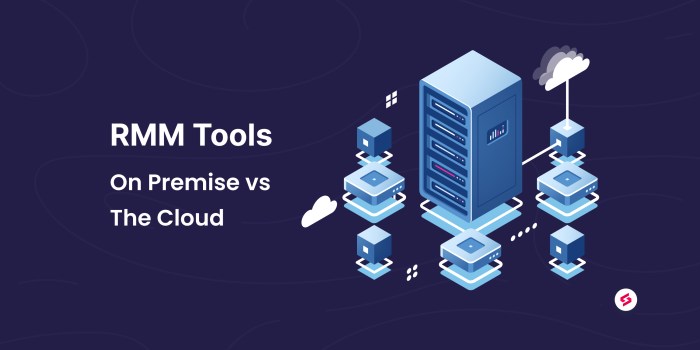
Implementing Cloud-based RMM software from different providers involves several key steps to ensure a successful deployment. Integration capabilities with other systems or tools offered by these providers play a crucial role in maximizing the benefits of the software. Here are some best practices for seamless integration and adoption of Cloud-based RMM software.
Implementation Steps
- Assessment of IT infrastructure: Conduct a thorough assessment of your current IT infrastructure to determine the compatibility and requirements for implementing Cloud-based RMM software.
- Vendor selection: Choose a reputable provider with a proven track record in delivering reliable RMM solutions and excellent customer support.
- Planning and customization: Develop a detailed implementation plan that includes customizations based on your specific needs and requirements.
- Training and onboarding: Provide comprehensive training to your IT team to ensure they are well-equipped to use the Cloud-based RMM software effectively.
- Testing and deployment: Conduct extensive testing to identify and resolve any issues before deploying the software across your organization.
Integration Capabilities
- API integrations: Many Cloud-based RMM software providers offer robust API integrations that allow seamless connectivity with other systems and tools, such as ticketing systems, CRM platforms, and monitoring solutions.
- Third-party integrations: Some providers offer pre-built integrations with popular third-party applications, enabling easy integration without the need for extensive development work.
- Data synchronization: Ensure that the Cloud-based RMM software can sync data across different systems in real-time to provide accurate and up-to-date information for monitoring and management purposes.
Best Practices for Integration
- Define integration goals: Clearly define your integration goals and objectives to ensure that the integration process aligns with your overall business strategy.
- Collaborate with IT teams: Involve IT teams from the early stages of integration planning to gather input and address any potential challenges proactively.
- Regular monitoring and optimization: Continuously monitor the integration process and performance to identify areas for improvement and optimization.
- Documentation and knowledge sharing: Maintain detailed documentation of the integration process and share knowledge among team members to facilitate seamless collaboration and troubleshooting.
Security and Compliance Considerations
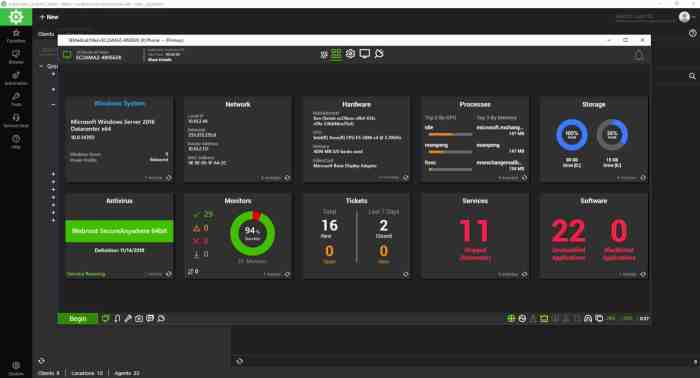
When it comes to Cloud-based RMM software providers, security and compliance are top priorities to safeguard user data and ensure adherence to industry regulations and standards. Let's explore the security measures implemented by these providers and how they address compliance requirements.
Security Measures Implemented
- Encryption: Cloud-based RMM software providers often encrypt data both in transit and at rest to protect it from unauthorized access.
- Multi-factor Authentication: Providers may implement multi-factor authentication to add an extra layer of security and ensure only authorized users can access the system.
- Regular Security Audits: Providers conduct regular security audits to identify vulnerabilities and address them promptly to enhance overall security.
Compliance with Industry Regulations
- GDPR Compliance: Cloud-based RMM software providers ensure compliance with the General Data Protection Regulation (GDPR) to protect user data and privacy.
- HIPAA Compliance: Providers also adhere to the Health Insurance Portability and Accountability Act (HIPAA) to safeguard sensitive healthcare information.
- PCI DSS Compliance: Compliance with the Payment Card Industry Data Security Standard (PCI DSS) is crucial for providers handling payment card data securely.
Examples of Security Breaches
- One notable security breach involved a Cloud-based RMM software provider that experienced a data breach due to a vulnerability in their system. Following this incident, the provider enhanced their security protocols, implemented stricter access controls, and conducted more frequent security assessments to prevent future breaches.
- In another instance, a provider faced a ransomware attack that compromised user data. As a response, they improved their data encryption methods, implemented real-time threat detection systems, and enhanced employee training on cybersecurity best practices.
Last Point
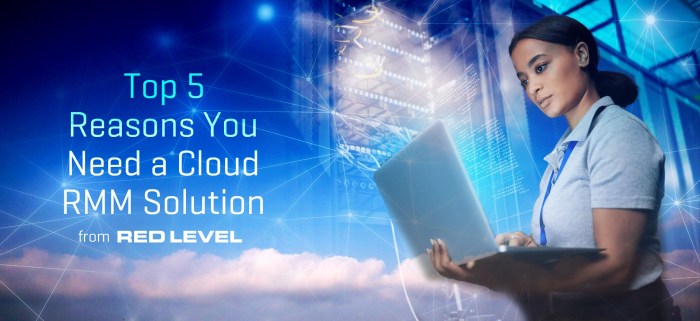
In conclusion, the world of Cloud-based RMM software providers offers a wealth of opportunities for businesses looking to revolutionize their IT management practices. By leveraging the benefits of cloud technology, businesses can enhance their operational efficiency, scalability, and security measures.
As the demand for innovative IT solutions continues to rise, embracing Cloud-based RMM software providers is not just a choice but a necessity for staying competitive in today's fast-paced digital landscape.
FAQ Explained
How does Cloud-based RMM software differ from traditional solutions?
Cloud-based RMM software operates on remote servers accessed via the internet, offering greater flexibility, scalability, and accessibility compared to on-premises solutions.
Which prominent Cloud-based RMM software providers are leading the market?
Some of the top providers include Atera, NinjaRMM, SolarWinds MSP, ConnectWise Automate, and Kaseya VSA.
What security measures do Cloud-based RMM software providers implement?
Providers implement encryption, access controls, data backups, and regular security audits to protect user data from cyber threats.




![Top 10 RMM Solutions [2024] | NinjaOne](https://ecommerce.mardinata.com/wp-content/uploads/2025/10/Best-RMM-Software-and-Tools-1-120x86.jpg)




